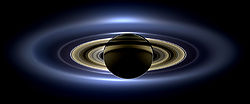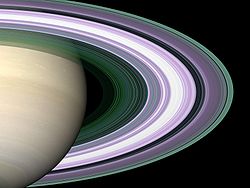Rings of Saturn
The rings of Saturn are the planetary rings around the planet Saturn, which can be seen with a small telescope. They consist of many small particles, ranging in size from microscopic to the size of a bus (or bigger) that form clumps that move around Saturn. The particles in the rings are made almost entirely of water ice,[1] with just a small amount of dust and other chemicals. There are some gaps in the rings. The moon Pan causes the gap called the "Encke gap" in Saturn's A ring.[2] The Cassini Division, discovered by Giovanni Domenico Cassini, is a gap between the A ring and the B ring. It is a product of orbital resonance.
Rings Of Saturn Media
The full set of rings, imaged on 19 July 2013 as Saturn eclipses the Sun from the vantage of the Cassini orbiter, 1.2 million kilometres (3⁄4 million miles) distant. Earth appears as a dot at 4 o'clock, between the G and E rings – with its brightness artificially exaggerated in this photograph.
Detail of Galileo's drawing of Saturn in a letter to Belisario Vinta (1610)
Simulated image using color to present radio-occultation-derived particle size data. The attenuation of 0.94-, 3.6-, and 13-cm signals sent by Cassini through the rings to Earth shows abundance of particles of sizes similar to or larger than those wavelengths. Purple (B, inner A Ring) means few particles are
A 2007 artist's impression of the aggregates of icy particles that form the 'solid' portions of Saturn's rings. These elongated clumps are continually forming and dispersing. The largest particles are a few meters across.
Saturn ring spokes PIA11144 secs15.5to23 20080926
References
- ↑ "The Rings of Saturn". Csep10.phys.utk.edu. 1995-11-21. Retrieved 2012-01-20.
- ↑ "Cassini Solstice Mission: Pan". Saturn.jpl.nasa.gov. 2004-07-01. Archived from the original on 2012-01-19. Retrieved 2012-01-20.









